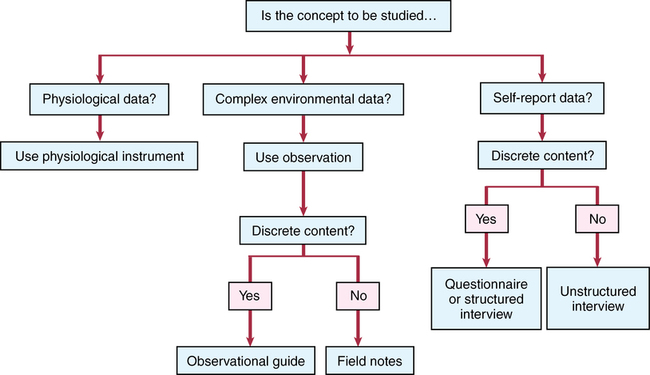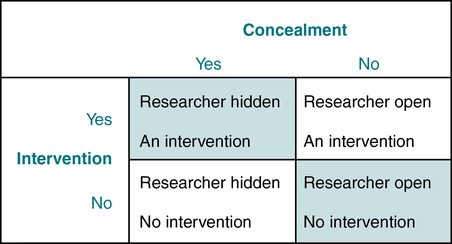CHAPTER 14 Susan Sullivan-Bolyai and Carol Bova After reading this chapter, you should be able to do the following: • Define the types of data collection methods used in nursing research. • List the advantages and disadvantages of each data collection method. • Compare how specific data collection methods contribute to the strength of evidence in a research study. • Identify potential sources of bias related to data collection. • Discuss the importance of intervention fidelity in data collection. • Critically evaluate the data collection methods used in published research studies. Go to Evolve at http://evolve.elsevier.com/LoBiondo/ for review questions, critiquing exercises, and additional research articles for practice in reviewing and critiquing. It is important that researchers carefully define the concepts or variables they are interested in measuring. The process of translating a concept into a measurable variable for data collection requires the development of an operational definition. An operational definition is how the researcher will measure each variable. For example, Thomas and colleagues (2012) (see Appendix A) defined quality of life as including the four domains of physical, social, emotional, and functional well-being measured by the FACT-G, which is commonly used in cancer studies. As you read research articles and the data collection techniques used, look for consistency with the study’s aim, hypotheses, setting, and population. Data collection methods may be viewed as a two-step process. First, the researcher chooses the data collection method(s) for their study. In this chapter the selection of measures and the implementation of the data collection process are discussed. An algorithm that influences a researcher’s choice of data collection methods is diagrammed in the Critical Thinking Decision Path. The second step is deciding if these methods are reliable and valid. Reliability and validity of instruments are discussed in detail in Chapter 15 (for quantitative research) and in Chapter 6 (for qualitative research). Measurement error is the difference between what really exists and what is measured in a given study. Every study has some amount of measurement error. Measurement error can be random or systematic (see Chapter 15). Random error occurs when scores vary in a random way. Random error occurs when data collectors do not use standard procedures to collect data consistently among all subjects in a study. Systematic error occurs when scores are incorrect but in the same direction. An example of systematic error occurs when all subjects were weighed using a weight scale that is under by 3 pounds for all subjects in the study. Researchers attempt to design data collection methods that will be consistently applied across all subjects and time points to reduce measurement error. Fidelity means that data are collected from each subject in exactly the same manner with the same method by carefully trained data collectors (see Chapter 8). To help you decipher the quality of the data collection section in a research article, we will discuss the three main methods used for collecting data: observation, self-report, and physiological measurement. 1. Observations undertaken are consistent with the study’s aims/objectives. 2. There is a standardized and systematic plan for observation and data recording. 3. All observations are checked and controlled. 4. The observations are related to scientific concepts and theories. Observational methods may be structured or unstructured. Unstructured observation methods are not characterized by a total absence of structure, but usually involve collecting descriptive information about the topic of interest. In participant observation, the observer keeps field notes (a short summary of observations) to record the activities, as well as the observer’s interpretations of these activities. Field notes usually are not restricted to any particular type of action or behavior; rather, they represent a narrative set of written notes intended to paint a picture of a social situation in a more general sense. Another type of unstructured observation is the use of anecdotes. Anecdotes are summaries of a particular observation that usually focus on the behaviors of interest and frequently add to the richness of research reports by illustrating a particular point (see Chapters 5 and 6 for more on data collection strategies). Structured observations involve specifying in advance what behaviors or events are to be observed. Typically, standardized forms are used for record keeping and include categorization systems, checklists, or rating scales. Structured observation relies heavily on the formal training and standardization of the observers (see Chapter 15 for an explanation of interpreter reliability). Observational methods can also be distinguished by the role of the observer. The observer’s role is determined by the amount of interaction between the observer and those being observed. These methods are illustrated in Figure 14-1. Concealment refers to whether the subjects know they are being observed, and intervention deals with whether the observer provokes actions from those who are being observed. Box 14-1 describes the four basic types of observational roles implemented by the observer(s). These are distinguishable by the amount of concealment or intervention implemented by the observer. Ethical issues can also occur if subjects are not fully aware that they are being observed. For the most part, it is best to fully inform subjects of the study’s purpose and the fact that they are being observed. But in certain circumstances, informing the subjects will change behaviors (Hawthorne effect; see Chapter 8). For example, if a nurse researcher wanted to study hand-washing frequency on a nursing unit, telling the nurses that they were being observed for their rate of hand washing would likely increase the hand-washing rate and thereby make the study results less valid. Therefore researchers must carefully balance full disclosure of all research procedures with the ability to obtain valid data through observational methods.
Data collection methods
Measuring variables of interest
Data collection methods
Observational methods
![]()
Stay updated, free articles. Join our Telegram channel

Full access? Get Clinical Tree


Data collection methods
Get Clinical Tree app for offline access


